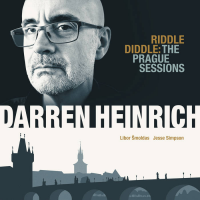Home » Jazz Articles » Getting Into Jazz » Maxine Sullivan: Together (Maxine Sullivan Sings The Mus...
Maxine Sullivan: Together (Maxine Sullivan Sings The Music Of Jule Styne)
If you're new to jazz, go to our Getting Into Jazz primer for some hints on how to listen.
CD capsule
What do you get if you take a 76 year old jazz singer who's seen a lot of life, surround her with a small group of premier jazz musicians and give her a bunch of vintage Jule Styne songs to sing? You get something you really ought to hear, a disc to warm your soul.
Background
Singer Maxine Sullivan's popularity peaked in the 1930s and 40's, with hit recordings, a series of successful club dates, a radio show, and well-received parts in a couple of movies. At that time she had a small, light voice, easy to listen to but easy to forget. To catch the flavor, listen to a few of Sullivan's early recordings, like "Night and Day" (1938) and "Skylark" (1947).
In 1958, she left the music business, and when she returned in 1966 at the age of 55, something had changed. Her voice, deeper and huskier, had lost some range and tonal purity, but it was gaining a new depth.
By 1987, when the Jule Styne album was recorded, Sullivan was 76 and her voice was even more limited. She sang some of the words, spoke others, and never ventured beyond a limited (yet still serviceable) range. But a kind of reverse metamorphosis had taken place: the pretty, delicate butterfly had finally become an even more beautiful caterpillar. There was now real substance to her singing, a wonderful inner glow, as though she were sharing some of the wisdom of a well-lived life. Sullivan died a few months later.
Does this sound like a downer? It isn't. The Styne songs selected for this album explore a range of human emotions from irrepressible joy to introspection, and Sullivan tackles them all with love and zest. You get the feeling that she's absorbed each song's story and that she's telling it to you with a kind, knowing heart. It helps that Sullivan can still swing easily when it's called for, and that she's surrounded by a group of excellent, like-minded jazz musicians who fill in the blanks and contribute some gorgeous solos: Keith Ingham on piano, Glenn Zottola on trumpet, George Masso on trombone, Phil Bodner on alto sax, Al Klink on tenor sax, Marty Grosz and Chris Flory on guitar, Phil Flanigan on bass, and the superb Jackie Williams on drums.
CD Highlights
Track 12, "Time After Time"
A favorite among jazz singers since it was written by Styne and Sammy Cahn in 1946, this is a quiet song with a quiet message, and it suits Sullivan perfectly. (Note that there's a Cyndi Lauper song with the same title, so specify "Styne" if you're searching on line.) The track opens with an extended tenor sax solo by Al Klink, as if to set the stage. Then at 2:21, Sullivan quietly comes in and sings/says the lyrics without embellishment, as though she means every word. Hear how the piano and sax make it a threesome, filling in to reinforce the feeling. After you've heard Sullivan do the song, listen to the fine renditions by Frank Sinatra, Nancy Wilson or Shirley Bassey. Notice that they're all reaching out to an audience. Sullivan is reaching out to you.
Track 16, "Together Wherever We Go"
This song has become a durable pop standard since Styne and Stephen Sondheim came up with it for the musical "Gypsy" in 1959. It never made a big splash among jazz musicians, but that doesn't stop Sullivan from turning into a joyful, rollicking paean to friendship. She starts out with a lighthearted swing at the verse, then gives way to a couple of pungent solos by clarinet and trombone before coming back for the reprise. Notice at 1:58 how the two horns back her up with a nice little scored arrangement. A happy tune to lighten what ails you.
Track 4, "Dance Only With Me"
The Great American Songbook has given us a generous handful of songs that say, in one way or another, "Time is short, let's love each other while we can." This beautiful example, with lyrics by Betty Comden and Adolph Green, is from the 1957 show "Say, Darling." A song like this can be particularly poignant in the hands of a singer who's actually staring mortality in the face, and Sullivan doesn't disappoint. Her treatment of the song is not morbid, or dramatic, or syrupy, or pleading. It's a simple, quiet statement about commitment, fleshed out with a gorgeous alto sax solo that makes it take flight. To appreciate how much of herself Sullivan invested in "Dance Only With Me," look up the original cast recording of "Say, Darling" and listen to the song as it was performed on the stage. Sounds pretty empty, doesn't it?
Track 7, "Bye Bye Baby"
If "Dance Only With Me" says "Life is short, let's be true to one another," this song, from 1949's "Gentlemen Prefer Blondes," has another message. "Brighten up," it says, "everything will be fine." Try listening to it first in the original cast album, where it comes off as a pleasant little ditty about not straying while your lover isn't around. Sullivan transforms it into a buoyant, lightly swinging tribute to optimism, jaunty and self-confident, yet deep-down wise. The musicians sustain the upbeat mood, with nicely arranged bits punctuated by Bodner's alto sax and Ingham's rollicking piano. When Sullivan gets to the part that says, "Though I'll be gone for a while, I know that I'll be smiling with my baby bye and bye," the words seem to take on a deeper meaning about having trust in the future, about strength, maybe even faith. One of these days, when you're dragging, try playing this track as a non-chemical pick-me-up. It works, it's free, and it won't give you a headache.
Track 8, "Killing Time"
You're going to need a pick-me-up after you sample this song, with lyrics penned by Carolyn Leigh ("You Make Me Feel So Young," "How Little We Know") shortly before her death in 1983. More than a song, "Killing Time" is a quiet haiku of hopelessness, a recitation of those ordinary, numbing acts of daily life that just might stave off utter despair. No silver lining here, no redemption, just loneliness without end. Notice how Styne has crafted the notes to fit the mood—using just a few of them, and in a very narrow range—and how Sullivan's approach to the song—she almost speaks the words, softly, ruefully—is true to its meaning. Just as true is Glenn Zottola's muted trumpet solo at 1:29, a perfect jewel. When Sullivan returns, at 2:21, he backs her until the close. This track may be a perfect downer, but it's beautiful. Go ahead, play it.
Personnel
Maxine Sullivan
vocalsAlbum information
Title: Together (Maxine Sullivan Sings The Music Of Jule Styne) | Year Released: 1987 | Record Label: Atlantic Jazz
Tags
PREVIOUS / NEXT
Support All About Jazz
 All About Jazz has been a pillar of jazz since 1995, championing it as an art form and, more importantly, supporting the musicians who make it. Our enduring commitment has made "AAJ" one of the most culturally important websites of its kind, read by hundreds of thousands of fans, musicians and industry figures every month.
All About Jazz has been a pillar of jazz since 1995, championing it as an art form and, more importantly, supporting the musicians who make it. Our enduring commitment has made "AAJ" one of the most culturally important websites of its kind, read by hundreds of thousands of fans, musicians and industry figures every month.




















